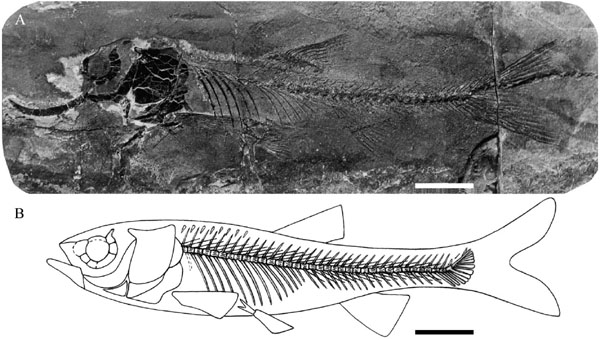SU De-Zao, a retired paleoichthyologist of Institute of Vertebrate Paleontology and Paleoanthropology, Chinese Academy of Sciences, found a new paleogene leuciscin fish, Tianshanicus liui sp. nov., in the Anjihaihe Formation in the Manas County in northern Xinjiang, as reported in the latest issue of Vertebrata PalAsiatic 2011(2), providing new materials for studying the origin, evolution, and interrelationships within the Cyprinidae. According to the nature of the fish-fauna and mammal fossils, the age of the fish-bearing beds is considered to be late Eocene, roughly 42 million years ago.
Cyprinidae is the largest family of freshwater fish, including subfamily Leuciscinae and several other subfamilies, occurring widely in Eurasia, Africa and North America. About 210 genera and 532 species and subspecies living cyprinids have been recorded in China, and more than 28 genera and 34 species of fossil cyprinids have been reported from Tertiary sediments in China. The earliest definite fossil cypriniforms (cyprinid and catostomid) are of Eocene age from China, but very few cyprinid fossils have been found in deposits earlier than Miocene.
Tianshanicus shows typical characters of the subfamily Leuciscinae, such as the anal fin with more than seven branched rays, body elongate-fusiform, mouth terminal, dorsal and anal fins without osseous spine, and the origin of the dorsal fin slightly behind that of the pelvic. It differs from other genera in the subfamily in the following characters: frontal broad anteriorly and narrow posteriorly, with greatly expanded postorbital process; parietal long, rectangular; sphenotic very large, arched; upper part of operculum as wide as lower one, roughly rectangular; dentary with low coronoid process; upper limb of preoperculum long, almost vertical; six hypurals, four of them upper hypurals; caudal fin with 19 principal rays and rounded upper and lower lobs.
Although fossil cypriniforms are represented most in Asia, the study has been largely neglected in China, owing to the poor preservation of most specimens and their limited significance to the high-level systematics. “The origin, evolution, and interrelationships within the Cyprinidae are still uncertain, mainly due to scarce information on fossil members of the group as well as of many extant Asiatic species”, said SU, “Tianshanicus liui shows typical characters of the subfamily Leuciscinae, and is of great interest for studying the origin of the subfamily Leuciscinae.”
Fig1: Holotype of Tianshanicus liui gen. et sp. nov., left side view (IVPP V 12172.1A) (Images by SU De-Zao) |
